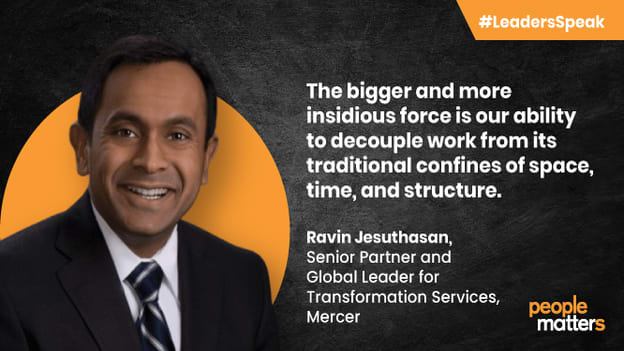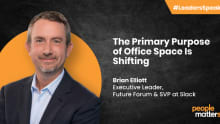Work Without Jobs: Ravin Jesuthasan on why it is time for organisations to reboot their work operating system

Jobs don't hold (are not confined to) a stereotypical definition anymore. The change requires deconstructing the current system to accommodate automation and agility.
Ravin Jesuthasan, Senior Partner and Global Leader for Transformation Services, Mercer, is one of those spear-heading the paradigm change.
A recognised global thought leader, futurist and author on the future of work and workforce transformation, Jesuthasan has led multiple research efforts on the global workforce, the emerging digital economy, the rise of artificial intelligence, and the transformation of work. He has led numerous research projects for the World Economic Forum (WEF) including many of its ground-breaking studies on work and workforce transformation. He is a regular participant and presenter at the WEF’s annual meeting in Davos and is a member of its Steering Committee on Work and Employment.
During an exclusive interaction with People Matters, Jesuthasan talks about his recent Wall Street Journal bestseller "Work Without Jobs" (MIT Press, 2022), co-authored with Professor John W.Boudreau of the University of Southern California’s Marshall School of Business and Research Director of its Center for Effective Organizations, and why it is time for organisations to reboot their work operating system to ensure the resilience, agility and flexibility required of the world of work today.
His other books are "Transformative HR" (Wiley, 2012), "Lead The Work: Navigating a World Beyond Employment" (Wiley 2015), "Reinventing Jobs: A 4-Step Approach to Applying Automation to Work" (HBR Press, 2018).
How would you define ‘Work’ without ‘Jobs’ and why the future of work requires the deconstruction of jobs and the reconstruction of work?
Work is traditionally understood as a “job,” and workers as “jobholders.” Jobs are structured by titles, hierarchies, and qualifications. In our book, we propose a new way of looking at work that deconstructs jobs into their component parts, deploys these parts to the optimal combinations of talent and automation and connects talent to work more seamlessly to make the most of the skills and abilities of individual workers.
COVID-19 impacted work and life globally. Microsoft CEO Satya Nadella, in April 2020, said: "We have seen two years' worth of digital transformation in just two months”. Looking back from here, the impact on the future of work is far more profound. It's more like a 20-year trend in these two years because of two forces. Certainly, digitalisation and automation is one factor, however the bigger and more insidious force is the democratisation of work… our ability to decouple work from its traditional confines of space, time, and structure.
The most obvious change we can all see is the shift to remote work during the pandemic and we typically think of the where and when of work, but what is the work? How is the work done? Things like job sharing, etc. Who's doing the work? Is it automation? Is it the employee? Is it an agile talent pool? And lastly, the Why of work. Why should I, as an individual, connect with what you as an organisation stand for or is your mission and purpose.
The future of work requires an ability to ensure that the organisation, its work, and its workforce are perpetually being reinvented to ensure their continued relevance even as they are perpetually being rendered obsolete.
In our new book, we lay out a roadmap for that future of work.
Do you have real-world cases that show how organisations are embracing work deconstruction and reinvention? Also, how sustainable is it?
We have many examples and cases of companies who are challenging the status quo, like Genentech, Unilever, DHL and Providence Health among others.
Biotechnology company Genentech deconstructed jobs to increase flexibility, worker engagement, and retention.
It was an opportunity for their progressive business and HR leaders to rethink their work operating model. They saw a terrible situation with the pandemic but realised it was an opportunity for them to challenge and question everything.
We've seen this framework applied in manufacturing, distribution, pharmaceuticals, financial services, construction and airlines among others and the same ideas have played out equally well.
In the book, we share the example of an agile data scientist pool in an insurance company, and showed how they had improved productivity by 600%.
So, there are really big gains in performance and productivity that are possible.
How can organisations determine when they have to make the shift to a new work operating system?
William Gibson, the great author, said: “The future is already here, it's just unevenly distributed”.
What we're talking about is challenging organisational muscle that is, in some cases, 150-160 years old. We tell all the organisations what you need to create is a prototype or proof of concept to challenge the status quo and illustrate the art of the possible and there are typically three possible starting points.
First is when you've got an operational process or a bottleneck, something's broken and not working. You can take the four principles and seven elements we talk about in the book and use it as a way to fundamentally solve the problem in a different way.
The second area is where you've made a decision to bring in a new technology. How do you ensure that when you introduce that technology, you've redesigned the work so that you get the maximum benefit from the technology?
And then the third is a very simple one. We have so many talent shortages today. Instead of just throwing more money at the problem, how would you redesign the work? We've seen this with the shortage of nurses in hospitals and in manufacturing roles where it's difficult to get talent for these frontline roles. We still have the pandemic, people are still getting sick, and the work is hard. So how do we make it easier for people to connect with work?
Those are three areas where there is an opportunity to prototype and try and do something different.
The last thing I will say is that what makes the new work operating system compelling is that the ROI is materially different. There is a real prize for doing this hard work and doing something different. It's not the usual five to 10% improvement, it is orders of magnitude greater
Does this change require a significant mindshift, both at the leadership level and employee level? How can this be prioritised with competing financial priorities?
We find it's really important that the voice of the employee be in the process because they're the ones closest to the work, but you have to make sure you do two things to get it right.
People have to have an incentive to want to help you and contribute. And, you have to ensure that there is the promise of a safe landing, because you're going to redesign the job and the person might say, "Oh, well, now it doesn't look like I can do this work or it's going to take me too long to reskill and it's easier for someone else to do it". So, you have to ensure that there is a promise of a safe landing as well.
But, again, this challenges a lot of legacy muscles. Hence this is a process that requires a lot of change management. It's a process that requires people to start with a specific playbook.
What's your message to policy-makers and individuals?
This is where there's a real opportunity for them. In the book we talk about not just what this means for companies, but how this could benefit individuals and nations so there are specific implications for regulators, policy makers and unions who are looking to protect the workforce.
Firstly, we're talking about seeing the whole person, not just the headline of the job, seeing all of the different ways individuals can contribute to different types of work. Each person has a unique set of skills and attributes. So how do we ensure that there is visibility with drawing clear pathways to the many different ways talent can connect to work as opposed to when you have a job and a job holder. When you limit work to this one-to-one relationship, you limit the opportunities for growth and advancement. That's why we hear from so many companies, it's easier for people to find work outside than it is inside.
That's always going to be true, even if you show them what jobs are available internally because you're limiting them to a job versus if you can say to someone, here is a body of work where you are three months away in terms of skill gaps. This is another opportunity which you might be nine months away from, in terms of closing the skill gaps, and we're going to help you be ready for multiple opportunities. Your growth is not just going to come from doing another job, but we're going to create a lot of opportunities for you to express your skills through projects, assignments and gates, etc, in different parts of the organisation.
That's going to then result in you getting paid more, because you have demonstrable skills that we can commercialise and you’re contributing to projects and assignments that make a difference to our business.
What are your views on major challenges that organisations face to adopt the new system and what retards the change? Would you like to share possible solutions as well?
Work without jobs is an idea whose time is here. There are two big challenges and hopefully we've addressed them in the book. The first big challenge is inertia and legacy. It is something completely different from what people have done for decades. It's different from everything we've told leaders to do and manage.
The second thing is how to get started? I am hoping that the book gives them the roadmap for overcoming legacy and moving forward.
It is both leaders and the processes that are holding organisations back. Take for example HR. Everything that we do is organised around this notion of a job right from how we hire people, develop them, deploy them, pay them.
We need HR to start questioning and challenging whether the existing structures and processes are fit for purpose. And again, in the book, we talk about how you rethink pay, rethink development and deployment etc. An organisation’s mindset, its toolset, its processes, its culture ...all of those are part of that legacy, the inertia.
How big a role has HR got to play in this shift to the new operating system?
HR has a massive role for two reasons. Firstly, we're seeing HR’s mandate shift from being a steward of employment, to increasingly being a steward of work.
Secondly, there's a lot of white space related to the new work operating system and that is an opportunity for HR to really step up and own this. There's no other function that can do it right. Strategy is typically focussed on “bigger picture” issues, finance is largely focussed on the reporting and monitoring of the operating model, but it's HR and the business that really need to own this. The time is perfect for HR to redefine its remit.






